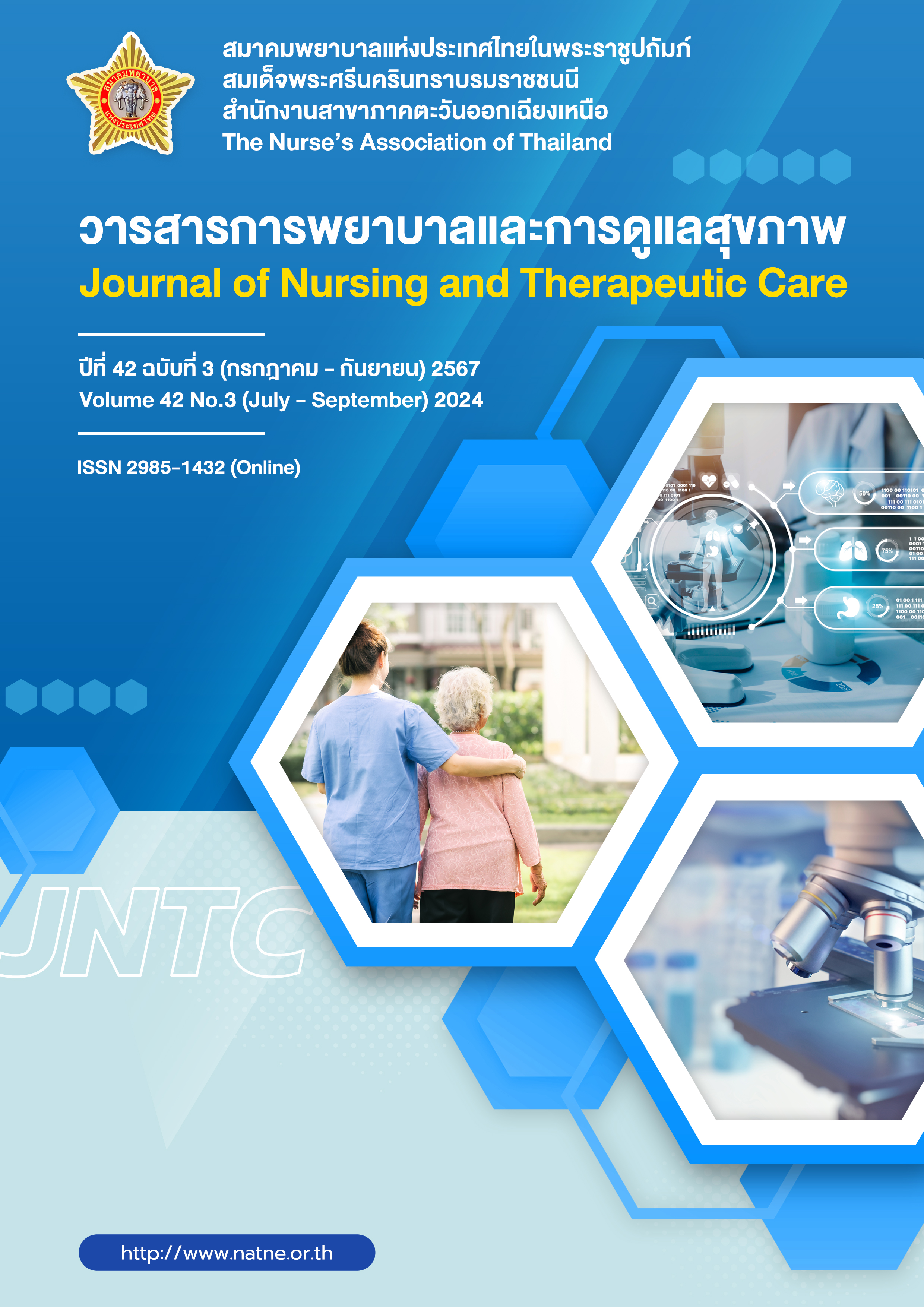ผลของโปรแกรมส่งเสริมการจัดการตนเองต่อความสามารถในการทำกิจกรรม ของผู้ป่วยหลังการผ่าตัดเปลี่ยนข้อเข่าเทียมในระยะฟื้นฟูสภาพ
คำสำคัญ:
โปรแกรมส่งเสริมการจัดการตนเอง, ความสามารถในการทำกิจกรรม, การผ่าตัดเปลี่ยนข้อเข่าเทียมบทคัดย่อ
การวิจัยกึ่งทดลองครั้งนี้มีวัตถุประสงค์เพื่อศึกษาผลของโปรแกรมส่งเสริมการจัดการตนเองต่อความสามารถในการทำกิจกรรมของผู้ป่วยหลังการผ่าตัดเปลี่ยนข้อเข่าเทียมในระยะฟื้นฟูสภาพ กลุ่มตัวอย่าง คือ ผู้ป่วยที่ได้รับการผ่าตัดเปลี่ยนข้อเข่าเทียม จำนวน 44 คน แบ่งเป็นกลุ่มควบคุมที่ได้รับการพยาบาลตามปกติจำนวน 22 คน และกลุ่มทดลองที่ได้รับโปรแกรมส่งเสริมการจัดการตนเองจำนวน 22 คน เครื่องมือในการทดลอง คือ โปรแกรมส่งเสริมการจัดการตนเอง ประกอบด้วย 5 กิจกรรมตามแนวคิดการจัดการตนเอง ได้แก่ 1) กิจกรรมการเตรียมความพร้อม และเรียนรู้กระบวนการจัดการตนเองที่ดี 2) กิจกรรมทบทวนความรู้ และปฏิบัติกระบวนการจัดการตนเอง 3) กิจกรรมเตรียมความพร้อมก่อนกลับบ้าน 4) กิจกรรมติดตาม กระตุ้นเตือนอย่างต่อเนื่อง และ 5) กิจกรรมติดตามต่อเนื่อง โดยแต่ละกิจกรรมใช้เวลาประมาณ 20-50 นาที ใช้ระยะเวลา 4 สัปดาห์ และเครื่องมือที่ใช้ในการรวบรวมข้อมูล คือ แบบประเมินความสามารถในการทำกิจกรรม ตรวจสอบคุณภาพของเครื่องมือ โดยผู้ทรงคุณวุฒิ 3 ท่าน มีความตรงตามเนื้อหา เท่ากับ .95 และคำนวณหาค่าสัมประสิทธิ์อัลฟาครอนบาคได้เท่ากับ .90 ดำเนินการวิจัยระหว่างเดือนตุลาคม พ.ศ. 2566 ถึง เดือนพฤษภาคม พ.ศ. 2567 วิเคราะห์ข้อมูลโดยใช้สถิติเชิงพรรณนา และสถิติการทดสอบค่าที
ผลการวิจัยพบว่า ค่าเฉลี่ยของคะแนนความสามารถในการทำกิจกรรมของผู้ป่วยหลังผ่าตัดเปลี่ยนข้อเข่าเทียมภายในกลุ่มทดลอง ระหว่างก่อนและหลังการทดลองมีค่าเท่ากับ 16 (S.D.=2.40) และ 43.18 (S.D.=1.46) ตามลำดับ โดยกลุ่มทดลองมีความสามารถในการทำกิจกรรมของผู้ป่วยหลังการผ่าตัดเปลี่ยนข้อเข่าเทียมในระยะฟื้นฟูสูงกว่ากลุ่มควบคุม อย่างมีนัยสำคัญทางสถิติที่ระดับ .05 ดังนั้นสามารถนำเอาโปรแกรมส่งเสริมการจัดการตนเองไปใช้ในการให้การดูแลผู้ป่วยหลังการผ่าตัดข้อเข่าเทียม เพื่อให้ผู้ป่วยมีทักษะการจัดการตนเองที่ดีหลังผ่าตัด มีการฟื้นฟูสภาพหลังการผ่าตัดอย่างรวดเร็วจนสามารถกลับมาดำเนินชีวิตได้ปกติ รวมถึงลดภาวะแทรกซ้อนที่อาจเกิดขึ้นในระยะหลังผ่าตัด
Downloads
เอกสารอ้างอิง
National Health Security Office. NHSO issues guidelines for knee osteoarthritis surgery, decentralizing power to districts to help patients access treatment [Internet]. 2019 [cited 2023 Aug 12]. Available from: https://www.nhso.go.th/frontend/NewsInformationDetail.aspx?newsid=MjA0OQ=
Hfocus. Green light! "Knee compress" service improves quality of life for gold card patients with osteoarthritis [Internet]. 2024 [cited 2024 Aug 7]. Available from: https://www.hfocus.org/content/2024/06/30738
Rabin N. Osteoarthritis [Internet]. 2024 [cited 2024 Aug 7]. Available from: https://www.med.cmu.ac.th/web/suandok/article-suandok/11840/
Charoenchonwanich K. Integrative knee osteoarthritis surgery. Bangkok: Siriraj Press; 2016. (in Thai)
Trakarnjan N, Yodphithak P. Rehabilitation of patients after artificial knee replacement surgery. Regional Health Promotion Center 9 Journal. 2020;14(34):271-84. (in Thai)
Apichantramethakul K, Sroisong S, Eiu-Seeyok B. Nursing for clients with knee osteoarthritis undergoing knee replacement surgery. Journal of Phrapokklao Nursing College. 2018;29(1):223-38. (in Thai)
Boonprakob T. Selected factors related to postoperative recovery in older person with total knee arthroplasty. [dissertation]. Bangkok: Chulalongkorn University; 2016. (in Thai)
Thabo Crown Prince Hospital. Report on statistics of patients with bone and joint disease; 2023. (in Thai)
Pedcharat W, Namjuntra R, Binhosen V, Porapakkham P. Effects of self-management program on self-management behaviors and readmission of patients with heart failure after valvular heart surgery. Thai Journal of Cardio-Thoracic Nursing. 2017;28(2):38-51. (in Thai)
Jantima P, Sritaratiku S. The effect of promoting self-management for health behavior modification of metabolic syndrome risk group. Nursing journal. 2017;40(2):162-71. (in Thai)
Creer TL. Self-management of chronic illness. In Boekaerts M, Pintrich PR, Zeidner M, editors. Handbook of self-regulation. San Diego: Academic Press; 2000.
Cohen J. Statistical power analysis for the behavioral science. 2nd ed. Hillsdale, NJ: Lawrence Erlbaum Association; 1988.
Jekel J, Katz D, Elmore J, Wild D. Epidemiology, biostatistics, and preventive medicine. Elsevier Health Sciences; 2007.
Pidet K. The effect of the self-management program on functional ability of patients with lumbar spine surgery in rehabilitation. [dissertation]. Bangkok: Chulalongkorn University; 2016. (in Thai)
Cronbach L. Coefficient alpha and the internal structure of tests. Psychometrika 1951;16(3):297-334.
Mayer TG, Mooney V, Gatchel RJ, Barnes D, Terry A, Smith S, et al. Quantifying postoperative deficits of physical function following spinal surgery. Clin Orthop Relat Res. 1989;(244):147-57.
Ritklar L, Wattana C, Kitipawong P. Effects of a self-management program on self-managment behaviors, dyspnea, activities of daily living, and quality of life among patients with congestive heart failure. Nursing Journal. 2012;39(1):64-76. (in Thai)
Kawi J. Self-management and self-management support on functional ablement in chronic low back pain. Pain Manag Nurs. 2014;15(1):41-50.
Wintachai T, Ua-kit N. Effect of a self-management program on pulmonary function in chronic obstructive pulmonary disease patients. Journal of Nursing Science Chulalongkorn University. 2018;30(2):124-35. (in Thai)
ดาวน์โหลด
เผยแพร่แล้ว
รูปแบบการอ้างอิง
ฉบับ
ประเภทบทความ
สัญญาอนุญาต
ลิขสิทธิ์ (c) 2024 วารสารการพยาบาลและการดูแลสุขภาพ

อนุญาตภายใต้เงื่อนไข Creative Commons Attribution-NonCommercial-NoDerivatives 4.0 International License.



